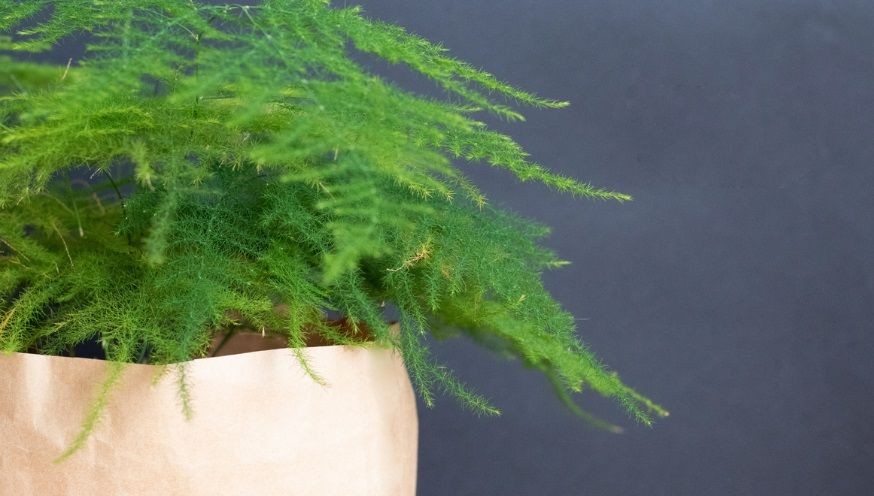Asparagus Fern, scientifically known as Asparagus setaceus and also charmingly referred to as Lace Fern or Plumosa Fern, is a beloved houseplant celebrated for its delicate, fern-like foliage. Despite its common name, it’s not a true fern but a member of the asparagus family. This evergreen perennial, native to Southern Africa, was first described in 1767 and gained popularity as an ornamental houseplant thanks to botanist Carl Ludwig Sprenger.
While the asparagus you might enjoy in a spring salad is a vegetable, the Asparagus Fern is purely ornamental. It brings a touch of soft, feathery greenery indoors and is remarkably adaptable, thriving even when conditions aren’t perfect. Its resilience comes from its thick, tuberous roots which store water and nutrients, enabling it to withstand drier periods. The soft texture of its foliage is a sensory delight, making it a joy to care for and touch. Unlike true ferns, Asparagus Ferns can produce small flowers and berries, adding to their unique appeal. They are also more tolerant of varied conditions than many shade-loving ferns.
Asparagus Fern Care: Top 10 Expert Tips for a Thriving Plant
- Optimise Light Exposure: Asparagus Ferns flourish in bright, indirect light. An east or west-facing window is ideal. If natural light is insufficient, supplement with grow lights.
- Water Mindfully to Prevent Overwatering: Allow the top half or even the entire soil to dry out before watering. Overwatering is a primary cause of root rot.
- Implement the Finger Soil Test: Before watering, insert your finger about two inches into the soil. Water only if the soil feels dry at this depth. A moisture meter can also be a helpful tool.
- Ensure Excellent Drainage: Asparagus Ferns are sensitive to waterlogged conditions. Use a well-draining potting mix and ensure your pot has adequate drainage holes to prevent standing water.
- Maintain Moderate Humidity Levels: Aim for humidity around 50%. Increase humidity by using a pebble tray filled with water, grouping plants, or employing a humidifier, especially in dry indoor environments.
- Fertilise During Active Growth: Asparagus Ferns benefit from regular feeding during the spring and summer growing season. Replenish soil nutrients with a balanced liquid fertiliser.
- Repot Every 2-3 Years as Needed: As your Asparagus Fern matures, it will require repotting. Plan to repot every few years or when you observe signs of the plant becoming root-bound.
- Prune Lightly to Encourage Bushiness: Regular light trimming of the asparagus fern encourages a denser, fuller shape and prevents overly leggy growth.
- Address Yellowing Fronds Promptly: Yellowing foliage can indicate various issues, from overwatering to nutrient deficiencies. Assess your care routine and adjust accordingly to promote healthy green growth.
- Regularly Inspect for Pests: Asparagus Ferns can attract pests like spider mites and mealybugs. Routine checks will help in early detection and prevent widespread infestations.
Detailed Asparagus Fern Care Guide
Light Requirements for Asparagus Ferns
Asparagus Ferns thrive in bright, indirect sunlight. In their native habitat, they often grow under the canopy of larger trees, which provides dappled shade and bright but filtered light. They can tolerate some direct morning or late afternoon sun, but harsh midday sun can scorch their delicate foliage, leading to browning and dryness.
For indoor settings, an east-facing window is often perfect, providing gentle morning light. A west-facing window can also work, but be mindful of intense afternoon sun, especially during hotter months. If you’re using a south-facing window, position the plant a few feet away from the window or use sheer curtains to diffuse the light. North-facing windows may not provide enough light, potentially leading to leggy growth.
Expert Tip: Asparagus Ferns’ preference for humidity and tolerance of lower light conditions makes them excellent choices for bathrooms. The naturally higher humidity in bathrooms mimics their preferred environment.
While adaptable to medium-shade conditions, insufficient light can negatively impact your Asparagus Fern. Lack of adequate light can result in weak, spindly stems, stunted growth, and pale or yellowing leaves. If you notice your plant stretching excessively towards the light source, it’s a clear sign it needs more light.
Watering Asparagus Ferns Correctly
Asparagus Ferns prefer consistently moist soil but are sensitive to overwatering. The key is to find a balance, allowing the topsoil to slightly dry out between waterings. Their tuberous roots store water, making them more forgiving of occasional dryness than consistently soggy soil.
A practical way to determine when to water is the finger test. Insert your finger about two inches into the soil. If it feels dry, it’s time to water. If the soil is still damp, wait a day or two and check again. Typically, watering once a week to every two weeks is sufficient, but this can vary based on environmental conditions, pot size, and plant size.
Expert Tip: Asparagus Ferns are relatively drought-tolerant due to their water-storing roots. They can recover from missed waterings more readily than from overwatering, making them a good choice for slightly forgetful plant owners.
Reduce watering frequency during the autumn and winter months when plant growth naturally slows down. Overwatering in cooler, darker months is a common mistake that can lead to root rot. Adjust your watering schedule to match the season and your plant’s reduced water needs. Understanding proper houseplant watering techniques is crucial for maintaining healthy, vibrant plants year-round.
Nutritional Needs of Asparagus Ferns
Asparagus Ferns are not heavy feeders, but they benefit from regular fertilisation during their active growing season to maintain their lush, green foliage. As they grow in pots, the nutrients in the potting mix become depleted over time, necessitating supplemental feeding.
Use a balanced liquid houseplant fertiliser diluted to half strength every 4-6 weeks from spring to late summer. A fertiliser formulated for general houseplant use will work well. Avoid over-fertilising, as this can lead to salt build-up in the soil and potentially damage the plant’s roots.
Reduce or cease fertilising during the autumn and winter months. As growth slows down in the cooler, shorter days, the plant’s nutrient requirements decrease. Fertilising during dormancy is unnecessary and can be detrimental.
Temperature and Humidity for Asparagus Ferns
Asparagus Ferns thrive in average room temperatures, ideally between 15-25°C (59-77°F). They are not cold-hardy and should be protected from temperatures below 10°C (50°F). Avoid placing them near drafts from windows or heating/cooling vents, as sudden temperature fluctuations can stress the plant.
Humidity is an important factor for Asparagus Fern health. They prefer moderate to high humidity levels, around 40-60% or higher. Dry indoor air, especially during winter when heating systems are in use, can lead to brown, crispy fronds.
To increase humidity, consider these methods:
- Pebble Tray: Place the pot on a tray filled with pebbles and water. As the water evaporates, it increases humidity around the plant.
- Plant Grouping: Grouping plants together creates a microclimate with slightly higher humidity.
- Humidifier: Use a room humidifier to maintain consistent humidity levels, especially during dry seasons.
- Misting: Regularly misting the foliage with lukewarm water can temporarily increase humidity, but ensure good air circulation to prevent fungal issues.
In winter, providing a slightly cooler resting period, around 13-15°C (55-59°F), can be beneficial. This cooler temperature mimics their natural dormancy period and prepares them for vigorous spring growth.
Soil and Repotting Asparagus Ferns
Asparagus Ferns are relatively fast-growing and will require repotting every 2-3 years. Repotting provides fresh potting mix and gives the roots room to expand. Choose a pot that is only slightly larger than the previous one, as Asparagus Ferns actually prefer to be slightly root-bound. Overly large pots can retain too much moisture, increasing the risk of root rot.
Good to know: Asparagus Ferns will sometimes indicate when they need repotting. Roots may start to emerge from the drainage holes, the plant may dry out more quickly than usual, or in extreme cases, the expanding roots can crack the pot.
Use a well-draining potting mix formulated for indoor foliage plants. A mix containing peat moss, perlite, and vermiculite is ideal. Organic potting mixes are also a good choice, providing nutrients and good drainage. When repotting, gently remove the plant from its old pot, loosen the root ball slightly, and place it in the new pot with fresh potting mix. Water thoroughly after repotting to help settle the soil.
Propagating Asparagus Ferns
Asparagus Ferns can be propagated by seeds and by division. Seed propagation is less common for indoor plants as berry production may be infrequent. Division is a simpler and more reliable method for home propagation.
Follow these steps for Asparagus Fern division:
- Remove the Plant from its Pot: Gently take the Asparagus Fern out of its pot and carefully remove excess soil from around the roots.
- Separate the Roots: Using your hands or a clean, sharp knife, carefully divide the root ball into sections. Ensure each division has healthy roots and foliage attached. Look for natural divisions in the root ball to make this process easier.
- Pot the Divisions: Plant each division in its own pot filled with fresh potting mix. Choose pots that are appropriately sized for the root ball of each division.
- Water and Care: Water the newly potted divisions thoroughly and place them in a location with bright, indirect light. Keep the soil consistently moist as the new plants establish themselves.
Propagation by division is best done in spring or early summer when the plant is actively growing. Be patient, as newly divided plants may take some time to establish and show new growth.
Common Pests and Problems of Asparagus Ferns
Asparagus Ferns are relatively pest-resistant but can occasionally be affected by common houseplant pests, particularly spider mites and mealybugs.
- Spider Mites: These tiny pests thrive in dry conditions and can cause stippling and webbing on the foliage. Regularly inspect your plant, especially the undersides of leaves, for signs of spider mites. Increase humidity and wash the plant with a strong stream of water to dislodge them. For severe infestations, insecticidal soap or neem oil can be used.
- Mealybugs: Mealybugs appear as small, cottony white masses, often found in leaf axils and on stems. Remove them manually with a cotton swab dipped in rubbing alcohol. Insecticidal soap can also be effective.
Prevention is key: Regularly inspect your Asparagus Fern for pests, maintain proper humidity levels, and ensure good air circulation to minimise the risk of infestations. Early detection and prompt action are crucial to prevent pest problems from becoming severe.
Toxicity of Asparagus Ferns
Asparagus Ferns are considered mildly toxic to humans and pets if ingested. The berries, in particular, contain compounds that can cause gastrointestinal upset if eaten. Keep Asparagus Ferns out of reach of children and pets that are prone to nibbling on houseplants. If ingestion is suspected, contact a veterinarian or medical professional for advice.
Purchasing Asparagus Ferns Online
For those looking to add an Asparagus Fern to their indoor plant collection, online retailers offer convenient options. You can purchase Asparagus Ferns in various forms, from seeds to starter plants, depending on your preference and patience level. Starting from seed can be a rewarding experience for those who enjoy watching the entire growth process. For quicker results, purchasing a young plant (“BabyPLNTS”) allows you to enjoy established foliage sooner. Reputable online plant shops can provide healthy plants delivered directly to your door, ensuring you get a thriving Asparagus Fern to care for.
In conclusion, Asparagus Ferns are beautiful, adaptable, and relatively easy-to-care-for houseplants that can bring a touch of soft greenery to any indoor space. By following these expert tips on light, watering, humidity, and pest control, you can ensure your Asparagus Fern thrives and remains a delightful feature in your home for years to come.

